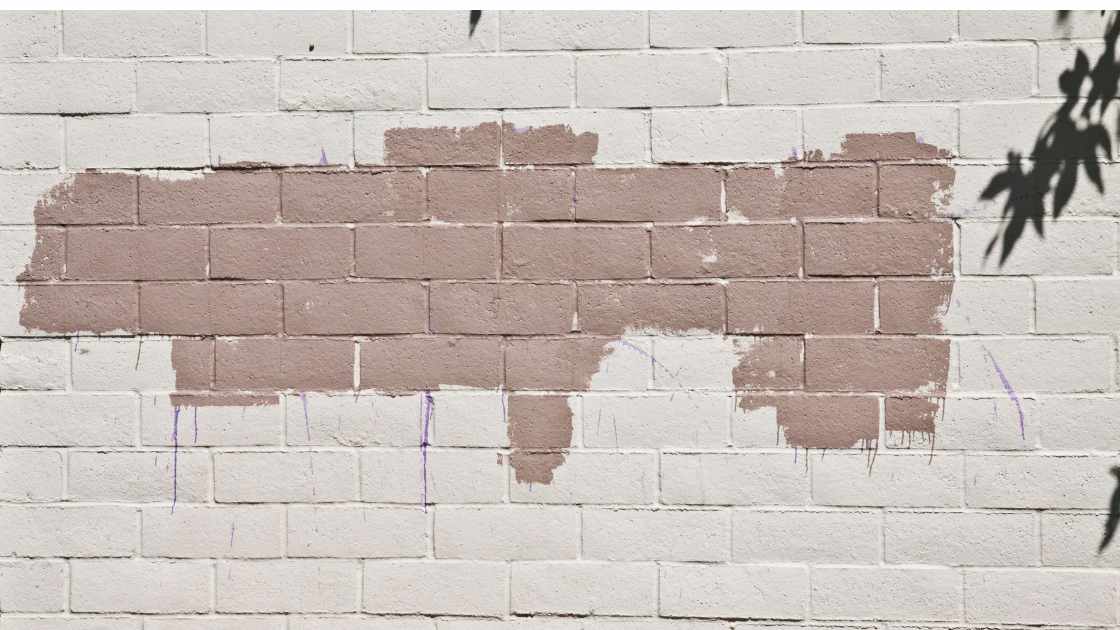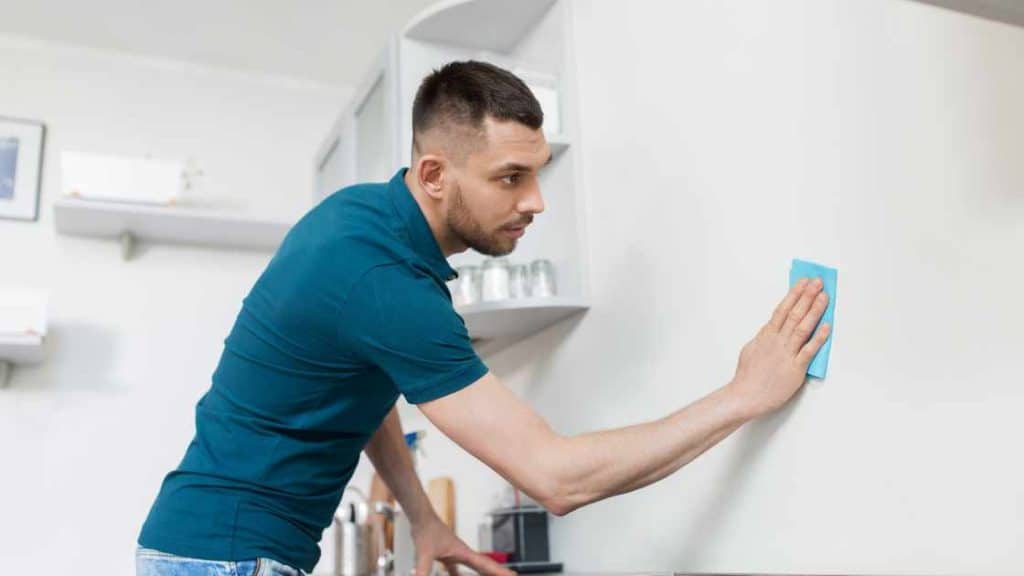To remove grease from walls without stripping the paint, use a mixture of baking soda and water. Apply with a soft sponge, then rinse gently with clean water.
Maintaining the pristine look of your painted walls poses a frequent challenge for many households, especially in high-traffic areas such as the kitchen, where airborne grease and splatters are inevitable.
It’s essential to find effective solutions to address this concern without causing any harm to the intricate painted surfaces that embellish your walls.
One common query is, “How to Remove Grease from Walls Without Removing Paint?” — a question that prompts exploration into practical and paint-friendly cleaning techniques.

It’s essential to find a balance between effective cleaning and preserving the integrity of your wall’s finish. The proper approach to removing grease begins with understanding the type of paint and preparing the right cleaning solution.
Using gentle yet efficient ingredients can cut through the grime while safeguarding the paint, ensuring your walls stay vibrant and protected after the cleaning process.
A careful hand and suitable materials help maintain the aesthetic of your home while removing unwanted splatters with ease.
Introduction To Grease Stains On Painted Walls
Painted walls beautify our homes, bringing life and personality to each room. But with daily activities, kitchen fumes, and accidental splashes, grease stains can turn a once pristine wall into a spotted mess.
Grease is a tricky adversary; it clings stubbornly to surfaces and resists simple cleaning methods. Striking the right balance between effective grease removal and paint preservation can be a true home-keeping challenge.
The Nature Of Grease Stains

Recognizing the properties of grease is essential for proper stain removal. Grease is oily and viscous, allowing it to adhere firmly to painted surfaces.
It can spread easily, increasing the cleaning area if not tackled correctly. If you know the science, you unlock the secrets to banishing these slick spots.
The Challenge Of Cleaning Without Damaging Paint

Walls with a coat of paint require a gentle touch when cleaning. Aggressive scrubbing can remove more than just the stain, leaving a patch of dull or bare plaster.
Hence, the goal is twofold: dissolve the grease and maintain the wall’s vibrant color and smooth finish. The perfect approach is one that atte,nds to both needs with equal care.
Preparation Before The Cleaning Process
Embarking on a mission to remove grease from painted walls requires some initial legwork to ensure the cleaning process goes smoothly and protects the integrity of the paint.
A careful approach preserves the wall’s finish and keeps the area free from water damage. Let’s get ready by organizing tools and preparing the space properly.
Gathering The Necessary Cleaning Supplies
Starting with the right tools is Vital. Use this checklist:
- Mild dish soap – A gentle yet effective grease cutter
- Baking soda – Great for tough spots
- White vinegar – A natural degreaser
- Warm water – To make the cleaning solution
- Sponges or soft cloths – Avoid scratching the paint
- Buckets – For mixing the solution and rinsing
- Rubber gloves – Protect your hands
Ensure all supplies are of good quality for best results.
Protecting The Surrounding Area From Water Damage
Take preventive steps to shield your space:
| Action | Purpose |
|---|---|
| Lay down towels or clothes | Catch drips and spills |
| Use plastic sheeting | Guard furniture and floors |
| Tape edges | Keep water out of unwanted areas |
These precautions protect your space and make cleanup easier.
Dry Cleaning Methods To Reduce Grease

Grease stains on walls can be stubborn, but they don’t always require heavy cleaning or paint jobs. Dry cleaning methods are effective for removing grease without damaging the paint.
These methods lift the grease without the need for water or liquid cleansers. This post explores two simple, yet powerful techniques to tackle grease marks: dry sponges and magic erasers.
Using Dry Sponges And Microfiber Cloths

Dry sponges, often used in soot removal, can also be effective for grease stains. The porous material absorbs grease as you gently dab the affected area. Avoid rubbing, as this can smudge the grease further. Microfiber cloths are another safe option. They trap grease due to their high absorbency. Follow these steps:
- Pat the stain with a dry sponge to absorb grease.
- Switch to a clean part of the sponge frequently.
- Finish off with a dry microfiber cloth to pick up any residue.
The Efficacy Of Magic Erasers On Grease Marks
Magic erasers are soft foam-like pads that can lift away grease effortlessly. They’re gentle on painted surfaces but tough on stains.
Always do a spot test in an inconspicuous area first. Gently rub the magic eraser on the grease mark in a circular motion. Replace the eraser as it picks up grime.
Be sure to apply only light pressure to prevent paint from coming off. Repeat until the grease is gone.
| Method | Action | Pointers |
|---|---|---|
| Dry Sponge | Patting |
|
| Microfiber Cloth | Dabbing |
|
| Magic Eraser | Circular motion |
|
These dry cleaning tactics are a quick fix to reduce grease on walls. With care, these strategies clean without peeling the paint. Say goodbye to grease without a trace!
Gentle Liquid Solutions For Grease Removal
Removing grease from walls without damaging the paint is a common household concern. Simple liquid solutions often provide the best results.
These methods are not only effective but also safe for your painted surfaces. Explore the wonders of diluted dish soap and homemade mixtures to tackle grease with care.
Diluted Dish Soap: A Gentle Grease Cutter

Regular dish soap, known for cutting through grease on dishes, also works wonders on walls. Using gentle dish soap diluted in water is a safe way to remove grease.
- Mix a few drops of dish soap with warm water.
- Use a soft sponge or cloth to apply the mixture to the wall.
- Gently rub the greasy area in a circular motion.
- Rinse with clean water and dry with a towel.
Homemade Mixtures: Vinegar And Baking Soda
Vinegar and baking soda together create a powerful cleaning solution without the harshness of chemicals.
| Ingredient | Mix Ratio | Instructions |
|---|---|---|
| White Vinegar | 1 part |
|
| Baking Soda | 2 parts | |
| Warm Water | 3 parts |
Spot Cleaning Techniques For Stubborn Stains

Spot Cleaning Techniques for Stubborn Stains help preserve wall paint. Greasy fingerprints or splatters are tough.
But there’s no need to repaint. With the right approach, walls look fresh without harsh chemicals.
Applying Cleaning Solutions With Precision
Mix gentle cleaners for safety. Use a soft cloth or sponge. Just dampen it, don’t soak it. Apply with care to target grease. Avoid spreading stains further.
- Dish soap cuts through grease.
- Baking soda offers mild abrasion. It removes without damage.
- Vinegar breaks down oily residue. But always dilute it first.
Test cleaners in a hidden spot. Wait for the wall to dry. Confirm no paint was harmed.
Rinsing And Blotting: A Delicate Balancing Act
Rinsing removes soap and grease. But too much water damages walls. Use a clean, damp cloth. Blot gently, don’t rub hard. Pat dry with a towel immediately.
| Step | Action |
|---|---|
| 1 | Apply cleaning solution lightly. |
| 2 | Rinse with a second clean cloth. |
| 3 | Blot, don’t rub, to avoid paint damage. |
| 4 | Pat dry gently and promptly. |
Always work from the outside in. This prevents the spreading of the stain. Repeat the steps if necessary. Patience is key to preserving your paint’s integrity.
Maintaining Paint Quality During Cleaning

Maintaining Paint Quality During Cleaning is crucial when tackling grease on walls.
It’s a balance between thorough cleaning and preserving the wall’s finish. Knowing the right approach ensures paint stays untouched while grease disappears.
Avoiding Harsh Chemicals And Abrasive Tools
Harsh chemicals and abrasive cleaning tools can damage wall paint.
- Opt for mild detergents or homemade solutions like vinegar and water.
- Avoid scouring pads which can scratch and dull the paint.
- Use a soft sponge or cloth for gentle wiping.
Tips For Preserving The Integrity Of Wall Paint
Preserve the integrity of your wall paint with these tips.
- Test cleaners in an inconspicuous area first.
- Pat, don’t rub when cleaning to avoid paint wear.
- Rinse walls well with clean water to prevent residue.
Post-cleaning Tips And Wall Maintenance

After the challenge of grease removal, it’s vital to keep walls looking pristine. Proper maintenance ensures the paint stays fresh, and grease doesn’t build up again. A few easy practices can protect your walls for years to come.
Preventive Measures To Protect Walls From Grease
Guarding your walls against grease starts with everyday habits. Here’s how to prevent grease from settling on your painted surfaces:
- Use Splatter Screens: While cooking, these can block grease from reaching walls.
- Exhaust Fans and Vents: Turn these on during culinary activities to help pull grease away.
- Backsplash Installation: Place an easy-to-clean surface between the wall and countertops.
Regular Cleaning Schedules For Long-term Wall Care
Consistent cleaning is the best way to keep walls in top condition. Stick to these simple steps:
- Weekly Dusting: Use a microfiber cloth to capture dust before it mixes with kitchen grease.
- Monthly Surface Clean: Gently wipe walls with a mild detergent and water mix.
- Immediate Spot Cleaning: Treat any grease splatters right away to avoid hard-to-clean stains.
By following these steps, your walls will not only remain clean but also retain their color and finish without the burden of grease damage.
Frequently Asked Questions For How To Remove Grease From Walls Without Removing Paint
What Is The Best Grease Remover For Walls?
The best grease remover for walls is a degreaser like Krud Kutter or a solution of vinegar and water. Apply gently with a sponge for effective cleaning.
How Do You Remove Stains From Walls Without Damaging Paint?
To remove stains from walls without damaging paint, gently wipe with a soft sponge dipped in mild soapy water. Rinse with a damp cloth, and pat dry with a towel. Avoid harsh chemicals and abrasive tools to protect the paint finish.
How Do You Get Oil Residue Off Painted Walls?
To remove oil residue from painted walls, mix a solution of warm water with a few drops of mild dish soap. Dip a soft cloth in the solution, wring it out, and gently scrub the affected area. Rinse with a damp cloth and dry with a towel.
How Do You Degrease Painted Walls?
Mix a mild, non-abrasive detergent with warm water. Dip a sponge into the solution, wring out excess moisture, and gently scrub the walls. Rinse with a damp cloth, then dry with a towel. Avoid harsh chemicals to protect the paint’s finish.
How do you remove stains from walls without removing paint?
To remove stains from walls without affecting the paint, mix a solution of equal parts white vinegar and water. Gently apply the mixture to the stain using a soft cloth or sponge, then wipe with a clean, damp cloth to lift the stain without damaging the paint.
How do you get grease off flat-painted walls?
To remove grease from flat painted walls, mix a solution of equal parts white vinegar and water. Gently scrub the affected area with a sponge or soft cloth soaked in the solution, then wipe it clean with water to reveal a grease-free surface.
Conclusion
Ending this guide, we’ve armed you with practical steps to tackle grease on painted walls. Adopt these suggestions to guarantee a wall surface that is clean and free from damage. Keep your walls pristine without compromising on their vibrant color. Share your sparkling results and spread the word on effortless, paint-safe cleaning!

